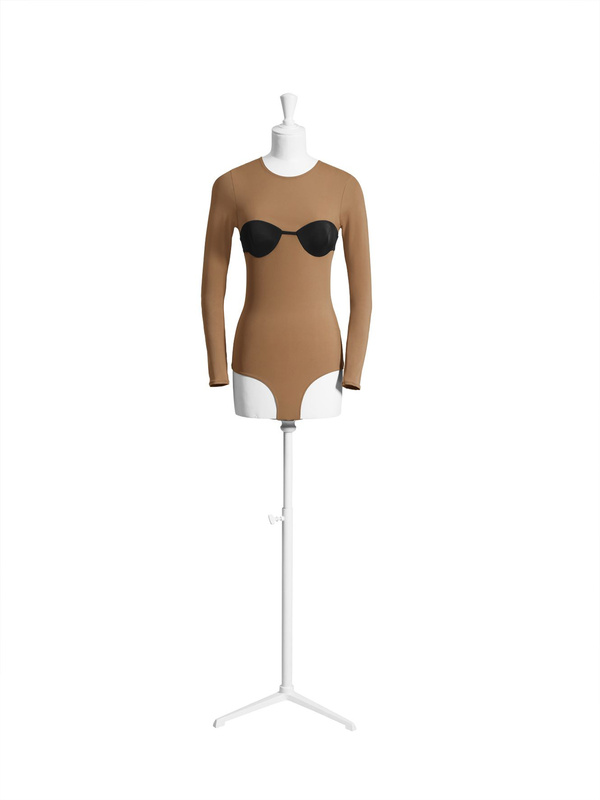FRANKFURT — Hennes & Mauritz is counting on a designer collection that includes a bodysuit with the image of a black bra across the chest to attract attention this holiday season. The rest of the Swedish retailer’s business is failing to do the same.
H&M just began selling a Maison Martin Margiela collection of about 100 items such as the $40 bodysuit, a $349 duvet coat, and oversized trousers for $129. While temporary offerings from top designers have figured in the company’s strategy since a 2004 Karl Lagerfeld line led to mobbed stores, for most of the year H&M struggles to remain as relevant as rival Inditex, the owner of Zara.
Despite the swell of enthusiasm and interest that accompanies the temporary collections, H&M has fallen behind Inditex in the race for the price-sensitive fashionista’s euro because most of its clothing takes months to get from design board to shop, said Daniel Lucht from consulting firm ResearchFarm in London.
Inditex designers seek inspiration from what customers are wearing and asking for, and get it to stores in weeks, Lucht said. That means Zara shoppers seeking the next new thing don’t have to wait for the special collections that typically come once or twice a year for H&M to boost its fashion bona fides.
“In terms of quality, H&M and Inditex are very similar so it all comes down to fashionability, style and design,” Lucht said. “Zara designs are a bit more elegant, a bit more out there.”
For investors, Inditex shares look better, too. The Spanish company’s stock is up 57 percent this year while H&M’s is down 1.6 percent. Inditex overtook H&M as Europe’s biggest clothing maker in 2006 and this year became Spain’s most valuable company. Its market capitalization now exceeds that of H&M and U.S. rival Gap Inc. combined.
H&M uses the temporary collections to drive publicity as well as sales. With Maison Martin Margiela – available at about 10 percent of its 2,600-plus stores worldwide – H&M is selling items like a $199 dress that appears to be worn horizontally rather than vertically and $299 wedge shoes with a clear heel so the wearer seems to float above the ground.
“There’s a lot of humor in Margiela’s design,” said Margareta van den Bosch, a creative adviser at H&M. The couturier “transforms garments and you wear them in a different way.”
H&M last year teamed up with Versace in a collection it said garnered “huge interest” and has worked with Madonna and Jimmy Choo previously.
“It’s great when designers like Anna Dello Russo or Versace come in and do a line as it is more fun and wearable than high-end fashion,” said Gemma Carmichael, 23, an assistant to fashion stylists in London.
Though the special collections don’t have a big impact on overall sales, they help infuse the company’s regular lineup with a greater sense of style and give H&M more credibility in the fashion world, said Manfred Abraham, head of consulting at London-based Interbrand.
“They are learning from the designers they are working with and they are incorporating that into their collections,” Abraham said. “H&M is taking a more extreme step into fashion.”
Consumers who buy Margiela’s creations, though, may not return to snap up H&M staples such as $10 leggings and $8 T-shirts, so the collections offer diminishing returns for the company, said Chris Nurko, the chairman of branding consultancy FutureBrand.
“Designer exclusives can be very limiting,” he said. “It is not a long-term viable solution for the master brand H&M.”
H&M, which opened its first store in Sweden in 1947, has been slower to diversify than Inditex. Brands other than Zara account for 62 percent of the Spanish company’s outlets and 35 percent of revenue. At H&M, by contrast, the four non-flagship brands – COS, Monki, Weekday and Cheap Monday – represent roughly 5 percent of total stores. Next spring, H&M will add a sixth brand, & Other Stories, with about 10 outlets across Europe selling pricier clothing, lingerie and accessories.
H&M must “take advantage of the relationship they have built with teenagers and exploit it when those teenagers grow up,” said Armando Branchini, founder of Milan-based consultancy Intercorporate. “Zara has an assortment that can be suitable for teenagers but also for their parents.”
– With assistance from Manuel Baigorri in Madrid.
Send questions/comments to the editors.



Success. Please wait for the page to reload. If the page does not reload within 5 seconds, please refresh the page.
Enter your email and password to access comments.
Hi, to comment on stories you must . This profile is in addition to your subscription and website login.
Already have a commenting profile? .
Invalid username/password.
Please check your email to confirm and complete your registration.
Only subscribers are eligible to post comments. Please subscribe or login first for digital access. Here’s why.
Use the form below to reset your password. When you've submitted your account email, we will send an email with a reset code.